Toxic Release Inventory
In 1986 the U.S. Congress passed a federal law called the Emergency Planning and Community Right-to-Know Act (EPCRA), which gives the public the right to know about industrial toxic chemicals that are released into the environment. At present this law, which is also known as Title III of the Superfund Amendment and Reauthorization Act, requires businesses in certain industries that manufacture, process, or otherwise use any chemical from a list of 651 designated chemicals or chemical groups in amounts greater than a certain threshold to report annually to the U.S. Environmental Protection Agency (EPA) on their releases of these chemicals. The EPA maintains this information in a database called the Toxics Release Inventory (TRI), which is available to the public over the Internet.
TRI Reporting Requirements
A plant, factory, or other facility must report chemical releases if it has ten or more full-time employees and manufactures, processes, or imports any of the listed chemicals in amounts greater than 25,000 pounds per year—or 10,000 pounds per year if any of the listed chemicals are otherwise used but not incorporated into a final product. The TRI classifies the chemicals according to their chemical and physical characteristics and contains information on release location. The TRI reports amounts that are released each year to the air, water, and land, as well as information on chemicals sent to waste-management facilities. Air emissions are separated into passive emissions
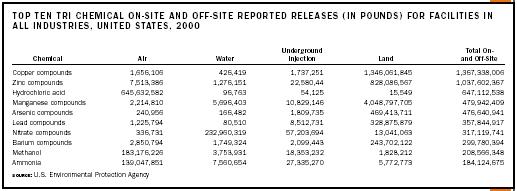
| Chemical | Air | Water | Underground Injection | Land | Total On- and Off-Site |
| SOURCE : U.S. Environmental Protection Agency | |||||
| Copper compounds | 1,656,106 | 426,419 | 1,737,251 | 1,346,061,845 | 1,367,338,006 |
| Zinc compounds | 7,513,386 | 1,276,151 | 22,580,44 | 828,086,567 | 1,037,602,367 |
| Hydrochloric acid | 645,632,582 | 96,763 | 54,125 | 15,549 | 647,112,538 |
| Manganese compounds | 2,214,810 | 5,696,403 | 10,829,146 | 4,048,797,705 | 479,942,409 |
| Arsenic compounds | 240,956 | 166,482 | 1,809,735 | 469,413,711 | 476,640,941 |
| Lead compounds | 1,225,794 | 80,510 | 8,512,731 | 328,875,879 | 357,844,917 |
| Nitrate compounds | 336,731 | 232,960,319 | 57,203,694 | 13,041,063 | 317,119,741 |
| Barium compounds | 2,850,794 | 1,749,324 | 2,099,443 | 243,702,122 | 299,780,394 |
| Methanol | 183,176,226 | 3,753,931 | 18,353,232 | 1,828,212 | 208,566,348 |
| Ammonia | 139,047,851 | 7,560,654 | 27,335,270 | 5,772,773 | 184,124,675 |
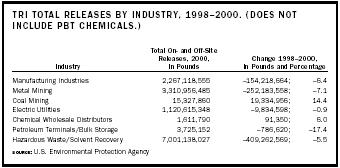
| Industry | Total On- and Off-Site Releases, 2000, in Pounds | Change 1998–2000, in Pounds and Percentage | |
| SOURCE : U.S. Environmental Protection Agency | |||
| Manufacturing Industries | 2,267,118,555 | –154,218,664; | –6.4 |
| Metal Mining | 3,310,956,485 | –252,183,558; | –7.1 |
| Coal Mining | 15,327,860 | 19,334,956; | 14.4 |
| Electric Utilities | 1,120,615,348 | –9,834,598; | –0.9 |
| Chemical Wholesale Distributors | 1,611,790 | 91,350; | 6.0 |
| Petroleum Terminals/Bulk Storage | 3,725,152 | –786,620; | –17.4 |
| Hazardous Waste/Solvent Recovery | 7,001,138,027 | –409,262,569; | –5.5 |
from storage or production and "stack" or point emissions. Releases to water include the name of the receiving water body.
Businesses required to report to TRI have expanded from the original manufacturing facilities and now include manufacturing, metal mining, coal mining, electric utilities that combust coal and/or oil, chemical wholesale distributors, petroleum terminals, bulk-storage facilities, hazardous-waste treatment and disposal facilities, solvent-recovery services, and federal facilities.
PBT Emissions
Persistent bioaccumulative toxic (PBT) chemicals are a class of compounds that persist and bioaccumulate in the environment. They have the potential to result in greater exposure to humans and the environment over a longer period of time, making even smaller quantities of these chemicals of concern. In 2000 the TRI was expanded to include new PBT chemicals, and the reporting threshold was lowered for both the newly added chemicals and certain PBT chemicals already on the TRI list. The reporting criteria for most PBT chemicals was lowered to a threshold of one hundred pounds if manufactured, used, or processed. A threshold of ten pounds was established for another subset of PBT chemicals that are highly persistent and highly bioaccumulative, including mercury compounds, pesticides such as chlordane,
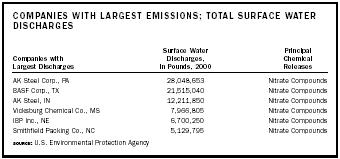
| Companies with Largest Discharges | Surface Water Discharges, in Pounds, 2000 | Principal Chemical Releases |
| SOURCE: U.S. Environmental Protection Agency | ||
| AK Steel Corp., PA | 28,048,653 | Nitrate Compounds |
| BASF Corp., TX | 21,515,040 | Nitrate Compounds |
| AK Steel, IN | 12,211,850 | Nitrate Compounds |
| Vicksburg Chemical Co., MS | 7,966,805 | Nitrate Compounds |
| IBP Inc., NE | 6,700,250 | Nitrate Compounds |
| Smithfield Packing Co., NC | 5,129,795 | Nitrate Compounds |
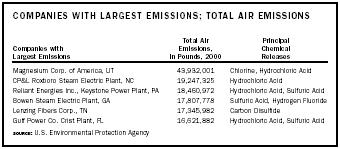
| Companies with Largest Emissions | Total Air Emissions, in Pounds, 2000 | Principal Chemical Releases |
| SOURCE: U.S. Environmental Protection Agency | ||
| Magnesium Corp. of America, UT | 43,932,001 | Chlorine, Hydrochloric Acid |
| CP&L Roxboro Steam Electric Plant, NC | 19,247,325 | Hydrochloric Acid |
| Reliant Energies Inc., Keystone Power Plant, PA | 18,460,972 | Hydrochloric Acid, Sulfuric Acid |
| Bowen Steam Electric Plant, GA | 17,807,778 | Sulfuric Acid, Hydrogen Fluoride |
| Lenzing Fibers Corp., TN | 17,345,982 | Carbon Disulfide |
| Gulf Power Co. Crist Plant, FL | 16,621,882 | Hydrochloric Acid, Sulfuric Acid |
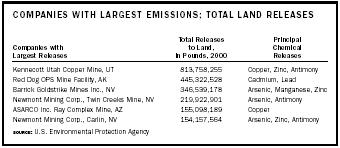
| Companies with Largest Releases | Total Releases to Land, in Pounds, 2000 | Principal Chemical Releases |
| SOURCE: U.S. Environmental Protection Agency | ||
| Kennecott Utah Copper Mine, UT | 813,758,255 | Copper, Zinc, Antimony |
| Red Dog OPS Mine Facility, AK | 445,322,528 | Cadmium, Lead |
| Barrick Goldstrike Mines Inc., NV | 346,539,178 | Arsenic, Manganese, Zinc |
| Newmont Mining Corp., Twin Creeks Mine, NV | 219,922,901 | Arsenic, Antimony |
| ASARCO Inc. Ray Complex Mine, AZ | 155,098,189 | Copper |
| Newmont Mining Corp., Carlin, NV | 154,157,564 | Arsenic, Zinc, Antimony |
heptachlor, methoxychlor, and toxaphene, polychlorinated biphenyls (PCBs), and polycyclic aromatic compounds (PACs). Since dioxins are highly persistent but are produced in extremely small amounts, the threshold for dioxin and dioxin-like compounds was set at 0.1 grams, with the provision that reporting include dioxin and dioxin-like compounds that are present as contaminants in a chemical or that are created during the manufacture of another chemical.
Reporting Trends
From 1998 to 2000, total TRI releases by all industries fell by 409.3 million pounds, or more than 5 percent. The largest decrease from 1999 to 2000 occurred in the metal mining industry.
SEE ALSO C OMPREHENSIVE E NVIRONMENTAL R ESPONSE , C OMPENSATION, AND L IABILITY A CT (CERCLA) ; H AZARDOUS W ASTE ; R ESOURCE C ONSERVATION AND R ECOVERY A CT .
Internet Resource
U.S. Environmental Protection Agency. "Toxics Release Inventory Program." Available from http://www.epa.gov/tri .
Joan Rothlein
Comment about this article, ask questions, or add new information about this topic: